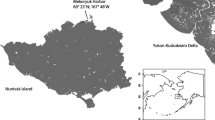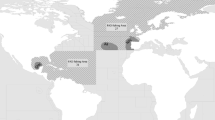Abstract
We analyzed white muscle samples from six species of Antarctic fish (suborder Notothenioidei) collected in 2011 from McMurdo Sound, Ross Sea, Antarctica, to assess levels of total mercury (THg). Gymnodraco acuticeps and Trematomus bernacchii exhibited the highest concentrations of THg followed by Trematomus pennellii, Trematomus nicolai, Trematomus newnesi and Pagothenia borchgrevinki, (71.3, 53.9 ± 32.1, 45.8 ± 27.3, 37.2 ± 18.6, 35.7 ± 23.6, and 21.9 ± 2.8 ng/g wet weight, respectively). The results from this study suggest that THg has the potential to bioaccumulate from various marine Antarctic ecosystems into biota.


Similar content being viewed by others
References
Alam MGM, Tanaka A, Allinson G, Laurenson LJB, Stagnitti F, Snow ET (2002) A comparison of trace element concentrations in cultured and wild carp (Cyprinus carpio) of Lake Kasumigaura, Japan. Ecotoxicol Environ Saf 53(3):348–354
Aronson RB, Thatje S, McClintock JB, Hughes KA (2011) Anthropogenic impacts on marine ecosystems. Ann NY Acad Sci 1223:82–107
Bargagli R (2006) Antarctic ecosystems: environmental contamination, climate change, and human impact. Springer, Berlin
Bargagli R, Monaci F, Sanchez-Hernandez JC, Cateni D (1998) Biomagnification of mercury in an Antarctic marine coastal food web. Mar Ecol Prog Ser 169:65–76
Blus LJ (2011) DDT, DDD, and DDE in Birds. In: Beyer WN, Meador JP (eds) Environmental contaminants in biota: interpreting tissue concentrations, 2nd edn. CRC Press, New York, pp 425–446
Bogillo V, Bazylevska M (2008) Variations of organochlorine contaminants in Antarctica. In: The fate of persistent organic pollutants in the environment. NATO Science for Peace and Security Series. Springer, Netherlands, pp 251–267
DeWitt HH, Heemstra PC, Gon O (1990) Nototheniidae. In: Gon O, Heemstra PC (eds) Fishes of the Southern Ocean. J.L.B. Smith Institute of Ichthyology, Grahamstown, pp 279–331
Eastman JT, McCune AR (2000) Fishes on the Antarctic continental shelf: evolution of a marine species flock? J Fish Biol 57:84–102
EPA (1999) The national survey of mercury concentrations in fish: data base summary 1990–1995. EPA-823-R-99-014. U.S. Environmental Protection Agency, Washington, DC
Focardi S, Lari L, Marsili L (1992) PCB congeners, DDT’s and hexachlorobenzene in Antarctic fish from Terra Nova Bay (Ross Sea). Antarct Sci 4(2):151–154
Geisz HN, Dickhut RM, Cochran MA, Fraser WR, Ducklow HW (2008) Melting glaciers: a probable source of DDT to the Antarctic marine ecosystem. Environ Sci Technol 42:3958–3962
Gloss SP, Grieb TM, Driscoll CT, Schofield CL, Baker JP, Landers D et al (1990) Mercury levels in fish from the upper peninsula of Michigan (ELS subregion 2B) in relation to lake acidity. EPA-600/3–90–068. U.S. Environmental Protection Agency, Washington, DC
Gon O (1990) Bathydraconidae. P. 364–380. In: Gon O, Heemstra PC (eds) Fishes of the Southern Ocean. J.L.B. Smith Institute of Ichthyology, Grahamstown, p 462
Halpern BS, Walbridge S, Selkoe KA, Kappel CV, Micheli F, D’Agrosa C, Bruno JF, Casey KS, Ebert C, Fox HE, Fujita R, Heinemann D, Lenihan HS, Madin EMP, Perry MT, Selig ER, Spalding M, Steneck R, Watson R (2008) A global map of human impact on marine ecosystems. Science 319:948–952
Honda K, Yamamoto Y, Tatsukawa R (1987) Distribution of heavy metals in Antarctic marine ecosystem. Polar Biol 1:184–187
La Mesa M, Eastman JT, Vacchi M (2004) The role of notothenioid fish in the food web of the Ross Sea shelf waters: a review. Polar Biol 27:321–338
Maggi C, Berducci MT, Bianchi J, Giani M, Campanella L (2009) Methylmercury determination in marine sediment and organisms by direct mercury analyser. Anal Chim Acta 641:32–36
Moore CW, Obrist D, Steffen A, Staebler RM, Douglas TA, Richter A, Nghiem SV (2014) Convective forcing of mercury and ozone in the Arctic boundary layer induced by leads in sea ice. Nature 506:81–84
Seelye JG, Hasselberg RJ, Mac MJ (1982) Accumulation by fish of contaminants released from dredged sediments. Environ Sci Technol 16:459–464
United States Environmental Protection Agency (1999) Method 1631, revision B: mercury in water by oxidation, purge and trap, and cold vapor atomic fluorescence spectrometry. EPA-821-R-99–005. Office of Water, Washington, DC
Author information
Authors and Affiliations
Corresponding author
Rights and permissions
About this article
Cite this article
Wintle, N.J.P., Sleadd, I.M., Gundersen, D.T. et al. Total Mercury in Six Antarctic Notothenioid Fishes. Bull Environ Contam Toxicol 95, 557–560 (2015). https://doi.org/10.1007/s00128-015-1594-5
Received:
Accepted:
Published:
Issue Date:
DOI: https://doi.org/10.1007/s00128-015-1594-5




